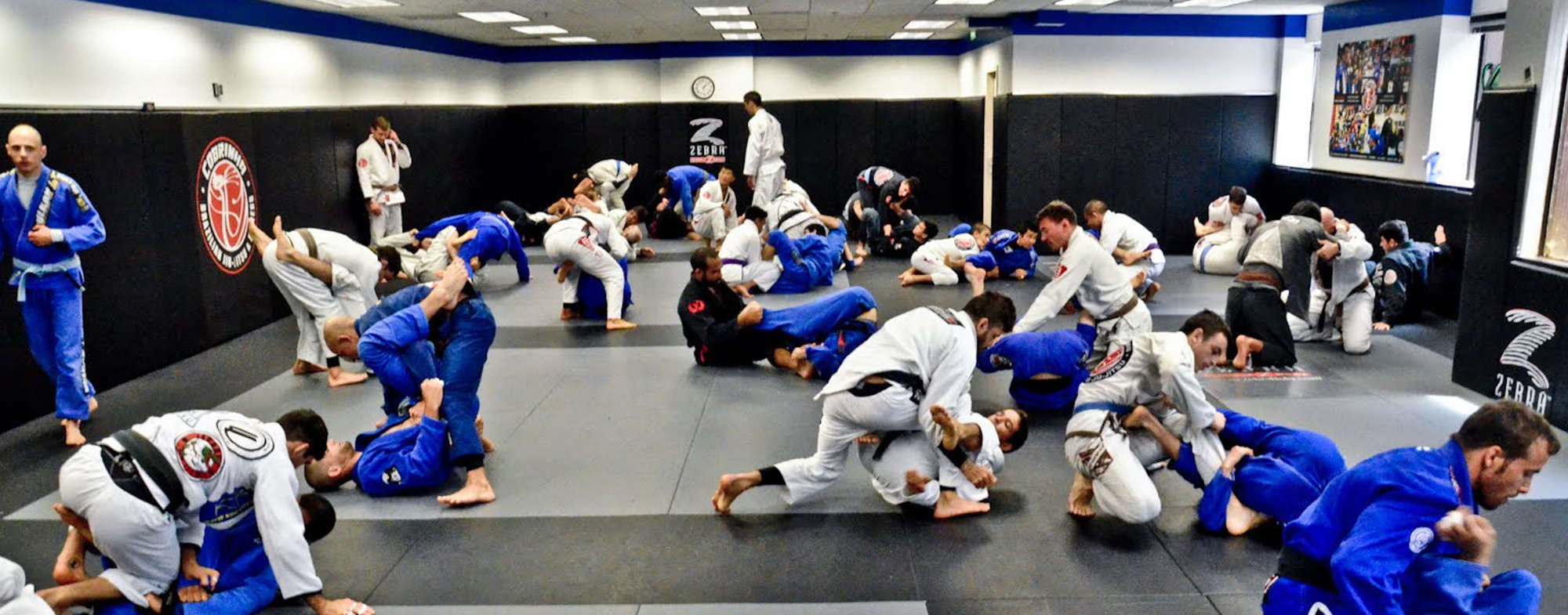SOFLETE Jiu-Jitsu Detachment
With the growing popularity of UFC, and consequently Mixed Martial Arts, and the U.S. Military’s focus on ground combatives as a hand to hand fighting solution, Brazilian Jiu-Jitsu has become one of the most popular combat sport systems in the United States today.
Finding a training home can be a challenge, but armed with the right mindset for training you will be able to find a facility and professor that can aid you in your journey.
Contrary to popular belief, the origination of the modern day ground fighting sport of Jiu-Jitsu originated in Japan, not Brazil. While the Brazilians have popularized Jiu-Jitsu in the US, the modern evolution of Jiu-Jitsu came from several other grappling sports such as Freestyle and Greco Roman Wrestling, Russian Sambo, Judo, Catch Wrestling and other grappling arts that blended in creating a unique modern Jiu-Jitsu.
Jiu-Jitsu - The Human Chess Game
Today Jiu-Jitsu is often referred to as “Human Chess” because it is very strategic, technical, and tactical, with countless moves that are exhausting both mentally and physically.
Consider this:
1. According to America’s Foundation for Chess, there are 169,518,829,100,544,000,000,000,000,000 ways to play the first 10 moves of a game of Chess. (FYI that’s 169 centillion, 518 octillion, 829 septillion, 100 sextillion, 544 quintillion… possible first ten moves.)
2. The Department of Defense did a study on muscle memory to better assess their marksmanship training showing how many repetitions it would take for physical movements to become “muscle memory”. This study showed that in order to make a “4 step presentation shot” (this is a basic technique broken down into 4 movements from the draw/holster) an average of between 2,000 to 3,000 repetitions would be needed.
Think about it: on a typical training session, one learns 2, maybe 3 techniques which are composed of an average of 2-5 movements (depending on the complexity of the situation and technique) that create one full technique.
Is your head hurting at the mere thought of all the possibilities or are you getting pumped? Learning Jiu-Jitsu isn’t a short or simple process, and it’s important to commit yourself to the idea of a long term learning curve, not a speedy career as a cage fighter.

Train Like You Fight, Fight Like You Train
After you begin to understand the enormity of the skill set of Jiu-Jitsu, you'll want to prepare yourself for some potential challenges along the way. Stressful learning environments, authoritarian instructors that can't explain things well, easily frustrated training partners that aren’t willing to allow the practicing of proper technique or that are only there to get the tap (there only to win) are all very real in the Jiu-Jitsu world.
These things matter because they create a very grim environment that can produce a long and difficult road filled with disappointment, frustrations, and injuries. These are amongst the most popular reasons why a lot of people get into Jiu-Jitsu and then quit shortly after they start.
“Train as you fight, fight as you train” is a popular saying in the combat sport and tactical realm. When you really think about it though, it doesn’t make much sense to apply that type of mindset when one is learning a new skill set (or learning something at all).
If one did fight as they trained, every time you stepped on the mat to train or compete you'd see red. You'd likely feel a pure and uncut adrenaline dump, nothing but absolute pure survival instinct would kick in. Your fight or flight instincts would overpower any reasoning and somehow make it okay to use anything and everything within your power to ensure that your opponent goes down... permanently (cause unknown).
Coming from a SOF background, I have seen what fight like you train looks like and know that training like you fight needs a little nuance in a technical fighting discipline. Make sure your training facility understands that nuance and isn’t pushing poor training methods in the name of “realistic scenarios”.
Jiu-Jitsu Training Environments and Methodology
I use the classic color coded “threat” metric to explain where on the spectrum your training should fall. Everyone that has flown on an airplane has likely seen the Department of Homeland Security’s threat advisory system: 3 easily identifiable colors signifying the gravity of the current threat condition:
Green: No risk, unguarded. This is chilling on the porch wearing Ranger panties, on your 17th PBR and can’t remember what happened to your shirt until you look at your kid wearing it as a diaper.
Amber: Significant probable risk, guarded. Best example is running late to work while there are plenty of savvy cops on the road at the end of the month trying to meet their quotas hiding and lurking everywhere. You are minding your speed, lane changes, signaling, seat belt, rear view mirror, side mirrors, gripping the steering wheel at a 10-2 position, no radio, just focus.
Red: Severe, high risk, heavily guarded. Woken up in the middle of the night to the sound of burglars in the house. Full adrenaline, 100% focus, every sound, smell, and sight is identified and analyzed. Leaping out of bed, clearing a path wearing nothing but ranger panties (maybe), full kit, nods and loaded .357, safety off, ready to put a hole the size of the grand canyon that will ruin the home invaders’ morale on a historical level.
Training for the red scenario is akin to learning how to shoot a pistol for the first time and after a couple hours the instructor gives you a nod and a smile, walks away, and starts shooting at you with live ammo to test what you have retained.
Is it the most realistic environment? Yes. Is it the best learning environment? Absolutely not. Training environments should be “Green” with a pinch of “Amber”, comfortable enough to be able to analyze and assess your movements, determining your opponent's movements, create openings, eliminate possibilities, calculate timing for counters, gauge escape plans, assess options, calibrate the movement for attacks.

How to Choose a Jiu-Jitsu Instructor
Below is is the daily outline I give my athletes to assist them in their journey. Better understanding of a complete training methodology allows them to focus on key learning points, in order to incorporate them into their own personal game plans.
Concept - The overall intent of what is being covered for the class.
Mechanics - Break down of the individual movements.
Technique - Individual movements strung together.
Strategy - Tactical approaches to the application of the techniques.
With these things in mind, ensure you have a comfortable Jiu-Jitsu learning environment that isn’t stressful as soon as you walk on the mats. The instructor should welcome well thought out questions regarding what is being taught at the time and be able to answer in a clear and concise manner.
My personal philosophy is “I only train black belts”. It is my sole responsibility to convey instruction in a comprehensive manner (yet easily understood by athletes that have anything from 10 days to 10 years of training). Your instructors should also try not to fall prey to the ever popular, “what if” questions. These tend to continue on and on and on, and they can easily drift into high variables which could go on for the entire duration of class if not controlled properly. It is best to focus on the task at hand, giving all your attention to learning in detail the specific movements.
The training environment is crucial; the average time it takes for someone to earn their Jiu-Jitsu black belt is 8 to 10 years, but the journey should be a rewarding and life-changing path that will affect you more than just on the mats.
Regardless of age, sex, body type, strengths or weaknesses, we'll always have room for personal growth in Jiu-Jitsu. My personal journey started over 22 years ago: it’s not just a part of me, it is my identity, and it continues to grow and shape my worldviews. I've made friends for life and I've had some of the most triumphant moments and personal achievements through the sport of Jiu-Jitsu. The best realization is that you never truly reach an end state in this sport, you only expand your understanding of a limitless problem.
Finding the right place to pursue this journey may take some time; don't give up. It may be a somewhat frustrating process; don't give up. Once you find that right place with the right people, it will become an incredible vehicle for self-discovery and development, so seek until you find, but whatever you do, don't give up.
Alan Shebaro earned his Black Belt from Carlos Machado in 2004 and is currently ranked as a 3rd degree Black Belt under Professor Chris Haueter. He most recently took 1st Place in the 2017 International Brazilian Jiu-Jitsu Federation Championships Masters International Championships (Barcelona, Spain), Black Belt Super Heavy Division. He is a former U.S. Army Special Forces Weapons Sergeant. He owns and operates Tier One Training Facility in McKinney, Texas where he trains multi-discipline athletes in sport performance and Brazilian Jiu-Jitsu. He is the co-founder of the We Defy Foundation, empowering combat disabled veterans through Jiu-Jitsu and physical fitness.





